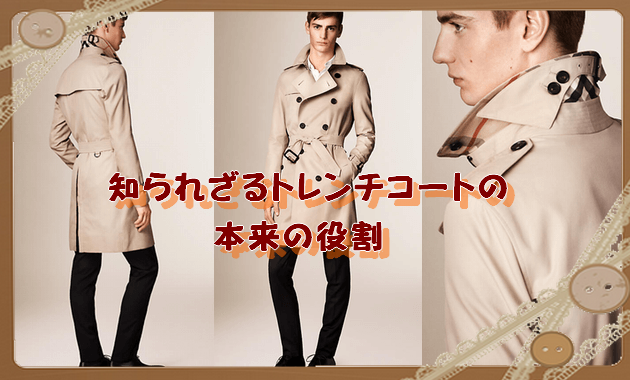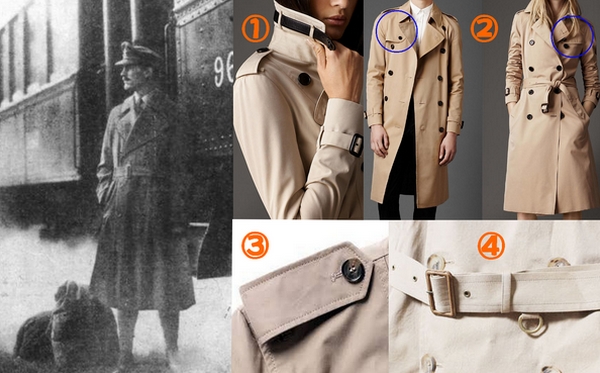KNIT MAGAZINE
All the questions about trench coats are solved!?Unexpectedly unknown birth story of that brand coat ♬

- Post date:
- August 9, 2016 07:00
KNIT MAGAZINE


We translate with Google Translate. You can contact us if you have any question.

Good morning ~ ヾ (o´ ヮ `) ノ ☆ 彡 Maruyasu Yarn is an office work Ogura ^^ ♬
Hot, hot, hot (No Д`)
The rainy season is finally over! Originally I like summer a lot, but with this humidity and heat, I’m already heroic (´ △ `;)
Please be alert and take appropriate amount of water and salt to prevent heat fatigue ~ ヽ (* ´∀ `) ノ
By the way, today I would like to talk a little about the bean knowledge of “trench coat” that I think everyone has one too ^^
The other day, I went shopping at a famous brand store in Ginza with a friend’s shopping. When you enter a good shop, you feel like you’re a higher-grade person, and your spine grows a little (laughs).
This year I want to buy the brand “trench coat” that my friend has wanted for a long time as a bonus! !! !! I entered the shop with enthusiasm and came straight to the corner of the court.
…Hmm? There are a lot of similar things, right? I thought that I was a stupid amateur, but there was no one with the same design on the coats lined up in a row Σ (゚ o ゚)
The collar design is different, the sleeve design is different, the belt design is different, etc. .. .. Again, fluffy! I was impressed, but I was also surprised by the skill of the shop clerk who accompanied us.
I’m pretty … No, when I go to the store with a lot of questions, I love to ask the shop clerk about this and that, and sometimes I get in trouble (´ × 👄 × `)
Without exception, I asked the clerk a lot of questions about what I was wondering about now, what I was wondering about all the time, and so on. But, but
As expected, a first-class brand shop! !! !! The clerk was also top notch. He answered all the core questions I asked perfectly, and my questions were cleared up, and the scales fell from my eyes o (^ ▽ ^) o Run
I would like to introduce the core “trench coat” bean knowledge that the shop clerk taught me ヽ (* ´∀ `) ノ ♬

History of trench coats
The origin of the trench coat was the British army of World War I, which was developed because of the demand for a waterproof military coat for the battle in cold Europe.
(“Trench” means “trench”. Groove to protect yourself from bombardment and shooting = “trench” was one of the basic positions)
Trench coats are land-based winter clothing, and were born as military wear from the beginning, as opposed to P coats and duffle coats, which originated from workwear that surpasses the cold of sailors.
The material also has history
With the start of World War II, two manufacturers have developed and emerged excellent raincoats. Needless to say, the two representative brands are “Burberry” and “Aquascutum”.
Thomas Burberry says that instead of weaving the cloth and then waterproofing it, he impregnates it with a special waterproof chemical at the thread stage to complete the “cotton gabardine”, which boasts stronger waterproofness. It has been. There is a theory that the reason for using twill weave is that it is stronger than plain weave.
Part names and roles
The characteristic detail of the trench coat. They are not just “decorations”, they were originally developed as military coats, and many are born for a variety of purposes needed on the battlefield.
☆ .. .: ・ Introduction of the original role of parts ☆. .: ・
① Throat latch / chin strap
A band called a chin strap is attached to the collar, and a strap is also provided on the wrist, and these can be tightened appropriately to prevent cold wind.
A small belt stored in the back of the collar found in full-scale trench coats. This is to cover the top of the hooked collar to prevent rain and wind from entering. Also known as Chin Warmer.
② Storm flap / gun flap
A gun flap that supported the stock of a rifle during World War I and protected the body from the impact of shooting. Larger than it was then, this design, which is buttoned over the label, still helps keep water out of the coat.
The patch sewn on the right chest (shoulder) is called a storm flap, which prevents raindrops from entering when all the collars are buttoned.
③ Epaulette
The epaulettes were originally attached with badges to indicate class and to prevent binoculars and water bottle straps from slipping off. Also, when a friend collapsed during the war, it was useful to hold this strap and pull it.
As an aside, it seems that the uniforms of the Japanese Self-Defense Forces also have epaulettes ^^
④ D ring
The D-ring (D-shaped metal fitting attached to the belt) is originally a device for hanging grenades and water bottles. At the time of World War I, it was used to lower military equipment.
It is now kept in shape as a decoration, but it is said that it is a remnant of the fact that it is firmly fixed to the stitched belt and its strength is maintained.

How is it? “Trench coat” that continues to be loved according to modern needs while inheriting the design that has kept the tradition for a long time. Would you like to buy it even if it is a little expensive? (´∀ ` *)
Subscribe Now
To receive the latest updates and insights, subscribe to our newsletter.
Contact Us
For further inquiries regarding this article, please feel free to contact us.